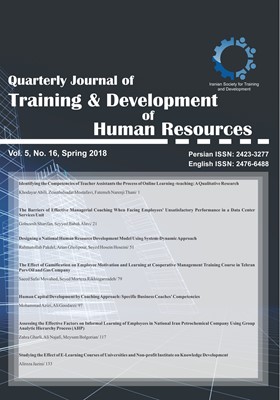Designing a National Human Resource Development Model Using System-Dynamic Approach
Subject Areas :
Rahmatollah Pakdel
1
,
Aryan gholipour
2
![]() ,
Syed Hosain Hosseini
3
,
Syed Hosain Hosseini
3
1 -
2 - مدیریت
3 -
Keywords: HR, National Human Resources Development, System-Dynamics Approach.,
Abstract :
Redesigning the systems and processes associated with each of them can have a significant effect on the guidance and management of the human resources of the country towards the goals and aspirations of the country's development and also prevent parallel and non-systemic actions & activities. This article designed with the purpose of providing a model for explaining the components and the way in which communication and interaction between policies, strategies, plans along with actions of each of these organizations and relevant ministries in the development of human resources. Based on the exploratory method, the required qualitative data for analysis is extracted for analysis based on the systemic approach, the interactions between national human resources components & subsystems and also system variables. The results of this study indicated that the National Human Resources Development System (NHRDS) has the main sub-systems of training and supply of human resources and labor market. These two subsystems are subordinated to HRM and Economic Development. In other words, the HR policies of the country act as inputs for the supply and labor market subsystem. Also, the causal circles derived from the six subsystems of this model, trace the effective variables and how to interact with each other and propose it as a basis for the solution presentation.
1. Gilley J, Maycunich A. beyond the Learning Organization: Creating a Culture of Continuous Development through State-of-the-are Human Resource Practices. 2000. Cambridge, MA: Perseus.
2. Alagaraja M, Wang J. Development of a National HRD Strategy Model: Cases of India and China. Human Resource Development Review, 2012;11(4), 407-429.
3. Sepehri M, Rustaazad R. 1404 Iran and Requirements for the Improvement of the Human Capital of the Country.2010. Tehran: Labor and Social Security Institute Publication.
4. Russ-Eft DKE. Watkins, V. J. Marsick, R. L. Jacobs, and G. N. McLean, (2014). “What Do the Next 25 Years Hold for HRD Research in Areas of Our Interest?” Human Resource Development Quarterly; 25(1): 5–27.
5. Devadas UM, Silong AD, Krauss S.E. Human Resource Development and the Contemporary Challenges of the World. Journal of Management Policy and Practice, 2011;12(5).
6. Ahmadvand A, Yavaribafghi A. Pattern of Human Resources Development in the Islamic Republic of Iran Police, Journal of Bahar Disiplinary Law. 2008; 39: 7-32.
7. Delgoshayi B, Tabibi S, Pahlavan P. The Presentation of the Human Resources Development Model in the Health Sector of Iran. Journal of Research in Medicine. 2007; 4: 317-325.
8. Akbarpour S. A Survey at the Employment and Unemployment Situation of University Graduates. Work and Society Quarterly. 2004; 53.
9. Ramazanpour N. Investigating the Relationship Between the Process of Human Resource Development and the Technology Process in Iran, Quarterly Journal of Improvement Management Management Studies, 2002; 9: 35-36.
10. Sparkman T E. Human Resource Development in Brazil: National Challenges International Issues, Human Management International Digest, 2015; 24: 25-39
11. Cox J.B, Arkoubi kh. Al & Estrada, S. D. National Human Resource Development in Transitioning Societies in the Developing World: Morocco, Advances in Developing Human Resources. 2006; 8(1): 84-98.
12. Asrar-ul-Haq M. Human Resource Development in Pakistan: Evolution, Trends and Challenges, Human Resource Development International. 2015;18(1): 97-104.
13. Alagaraja M, Githens R. Capacity and Capability Building for National HRD, Human Resource Development Review. 2016; 15(1): 77-100.
14. Nasehifar V, Askarimasule S. Explaining the Model of Human Resource Development Based on the Islamic-Iranian Pattern of Progress, tomorrow Management Board. 2016; 51: 1-22.
15. Hashemirad S. Pattern of Human Resources Development at the National level in Pursuit of the Goals of the Country's Twentieth views, PhD Thesis, Faculty of Management, Allame University, Tehran, Iran. 2010.
16. Sterman JD. Business Dynamics: System Thinking and Modelling for a Complex World, 2000. Irwin /McGraw-Hill.
17. Rostami H. Effects of Immigration of Specialized Labor Force to Labor Market. Work and Society Monthly journal (Social, Economic, Scientific and Cultural). 2015;190: 49-57.
18. Jalili T. Financial Crisis and Pension Funds, Tehran, Insurance Studies and Research Unit of the Audit Institute of the State Pension Fund. 2009.
19. Aghaii N. A Comparative Study on the Effects of Demographic, Economic and Social Factors on Human Resource Productivity in Education and Training in Tehran. Sport Management and Motor Behavioral Research, Seventh Year. 2011; 14: 113-130.
20. Ahmadipour L. Yousefi G. Proficiency in Employing and Recruiting Workforce, Work and Society Monthly Paper (Social, Economic, Scientific and Cultural). 2014; 172: 72-78.
21. Khanifar H, Emami M, Purebrahim S. Investigation and Measurement of Employee Proportionality of Employees and Providing Solutions for Its Improvement (Case Study in Iran National Oil Refining and Distribution Company), Quarterly Journal of Management and Human Resources in Oil Industry. 2010; 11: 41-58.
22. Eslami S. Measuring the Social Welfare Index over the Past Four Decades in Urban Areas of the Country. Economic Magazine. 2014; 5: 5-28.


